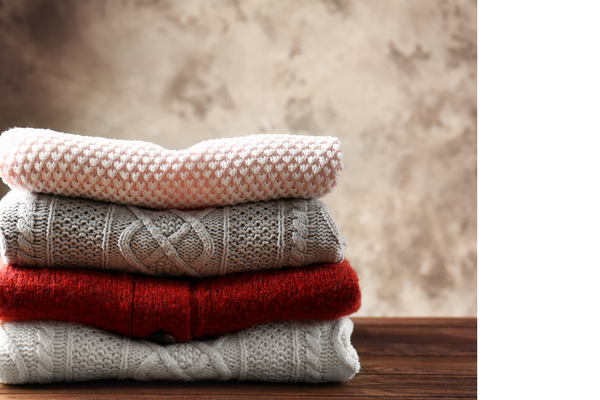How to Store Your Knits

Caring for your handmade garments is one of the most important parts of the whole making experience. Cleaning and storing your hand-knitted or hand-crocheted items correctly will have a huge impact on their longevity and ensure that they are looking as good as new for years to come.
At the end of the cooler months, it's the perfect time to store your warm handmade knits and accessories. Here’s a step-by-step guide on how to properly store your knits for the warmer months.
Take Stock of your Knits
Before storing your knits, inspect them for any small repairs or maintenance. Now is the perfect time to mend any holes, adjust loose woven ends, and de-pill your garments. This step will ensure your garments stay fresh and ready for next winter.
Pro Tip: Save a small ball of yarn from each project for future repairs.
De-pilling
Pills are small balls of accumulated fluff that are inevitable on a knitted garment. They usually occur in areas of high friction, such as underarms or even shoulders that have had bags worn on top of them. They also occur more regularly in softer fibres and those that have a shorter staple length. For most garments you will notice more pilling at the beginning of its life that will settle down once the short lengths of fibre have been worked out and removed.
For an easy and effective solution, try the Battery-Operated Lint Remover. This handy tool quickly removes pills and fuzz from your garments without damaging the fabric.
Washing your Knits
Washing your woolens before storing them is essential to protect against pests like moths, which are attracted to skin oils and dirt. Wool is naturally antimicrobial, so you don’t need to wash it after every wear. Instead, air it out and handle it gently.
We recommend washing your garments by hand, even if the yarn is machine washable, as this is gentler and will protect your hard work.
-
Step 1: Fill a bathtub or basin with cold water and a few capfuls of Soak Wool Wash. This no-rinse wool wash is perfect for delicate garments and will prevent excessive handling.

-
Step 2: Submerge like-colored garments (ensure they're colorfast) and let them soak for 20 minutes.
-
Step 3: If washing colourwork or garments that might bleed, add a few tablespoons of white vinegar and soak for only 10-15 minutes.
Once soaked, gently squeeze out excess water without wringing the garment. Soak Wool Wash helps to keep your garments soft and fresh while reducing the risk of damaging them.
Drying your Knits
Avoid hanging your knits to dry as the weight of wet garments can cause stretching. Instead, roll each garment in clean towels to absorb excess water, then lay it flat on blocking mats or dry towels. Always dry your wool garments in the shade to prevent fading from direct sunlight.
Tip: If your garment needs reshaping, you can pin it into shape while drying. Learn more about the blocking process in our blocking blog post.
Storing your Knits
Once your knits are dry, fold them carefully. Always store them flat to prevent distortion. Consider using a cedar chest or dresser, as cedar is a natural moth repellent. Alternatively, store your garments in plastic tubs with cedar blocks or lavender sachets.
If you need to store garments in plastic bags, ensure the bags are sealed securely and allow the wool to breathe. If you live in an area with moths or other pests, adding mothballs may be necessary, but use them sparingly due to their strong scent.
Final Care and Inspection
When you're ready to wear your knits again, simply take them out, let them air out, and check for any signs of pest damage. If you find any damage, take immediate action by cleaning all garments that were stored together and freezing them to kill any pests.
By following these steps, you’ll ensure your knitted garments are safely stored and ready for the next season. For more tips on caring for your handmade knits, explore our care products and store them in perfect condition.
If you have any storage tips or questions, feel free to share them in the comments! And if you’re working on a project using our yarn, don’t forget to tag us on social media with #morrisandsons—we love seeing your creations!









We are so glad you liked the article!
We have a good Birch Electric Lint Shaver – here is a link. https://morrisandsons.com.au/products/lint-remover-battery-operated?pos=1&_sid=d943fb526&ss=r
Please let us know if you have any other questions.
No Cedar chest!
However where can I buy a good electric de-pilling razor?
Thanks,
Leni